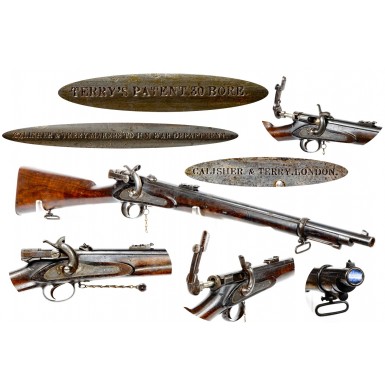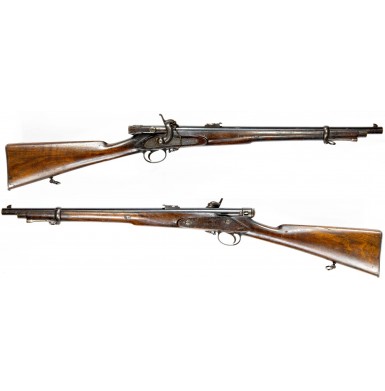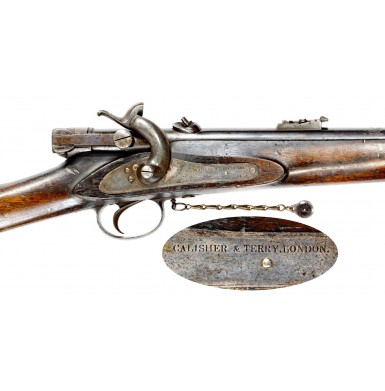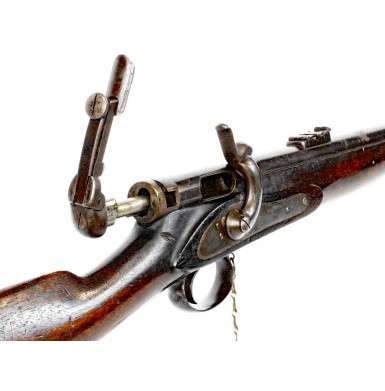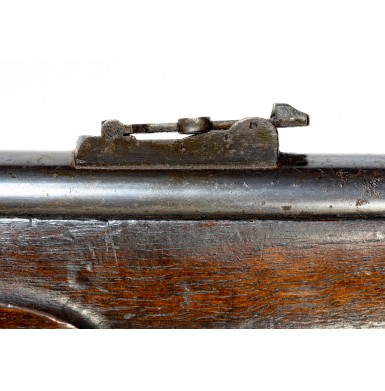Extremely Rare & Fine Calisher & Terry Carbine - Likely A Confederate Purchase
- Product Code: FLA-3692-SOLD
- Availability: Out Of Stock
-
$1.00
The Terry’s Patent Carbine, as produced by the Birmingham firm of Calisher & Terry was one of the more unique and innovative breechloading percussion arms to be developed in the mid-19th Century. The guns have always had a strong Civil War association with the Confederacy, primarily because of two very famous carbines that are in the collection of the American Civil War Museum (formerly the Museum of the Confederacy). One of these guns belonged to Confederate President Jefferson Davis, while the other belonged to famed Confederate cavalry general J.E.B. Stuart. Stuart’s gun was a 30-Bore Type II carbine that is serial number 4928, with the retailer name THOMAS BLISSETT – LIVERPOOL engraved on the top of the barrel. While documentable official deliveries of additional Terry carbines have not yet been located, a period Confederate document does establish the order of 5,000 of the carbines, although it is unclear how many may have actually been delivered. Additionally, it is possible that as many as 200 may have been purchased by the US Government.
In 1861, Henry Calisher traveled to New York with “200 Long Enfields”, which he offered for sale. It is not clear whether the guns were in fact Enfields, and in all probability they were really Terry’s Patent carbines. Additionally, sources are split as to whether the guns were sold directly to the US government or the firm of Schuyler, Hartley & Graham of New York. It is well known that a number of high profile arms were delivered to the Confederacy through purchases at the Schuyler, Hartley & Graham storefront in New York, so it is quite possible that at least some of these carbines went south as well, via a “straw man” purchase by Southern sympathizers. Terry carbines may also have travelled to the Confederacy as speculative cargo in the holds of Confederate blockade runners as well. Speculative cargo were those items purchased by the owners and/or investors in the blockade runner, who were allowed to import items to the South for their own monetary gain. Recent discoveries in US Maritime Court Records have revealed that many items never thought to be purchased by the Confederacy were in fact purchased as speculative cargo for resale upon their arrival in the South. Among these speculative weapons imports were Austrian Model 1851 cavalry carbines, as well as Austrian Model 1838 and Model 1842 muskets.
Terry’s Patent Carbines have long been considered a rarely encountered arm, imported in very limited quantities by the Confederacy, and have been identified as such since the days of Claude Fuller & Richard Steuart’s Firearms of the Confederacy (pages 231-232 & Plate XXVI, Figure 3) and William Albaugh & Edward Simmons’ Confederate Arms(Plate 99, Figure 3). Recently, however, one of the documents discovered within the McRae Papers provides the confirmation that the Confederacy tried to acquire a number of Terry’s Patent Carbines and in my mind absolutely proves that the Confederacy probably received at least a handful of these guns beyond the samples that were delivered to J.E.B. Stuart and Jefferson Davis. The document is a four-page letter from Colin McRae to an unknown recipient. The letter was sent from Paris and is dated December 3, 1863. McRae’s letter makes some interesting requests and reads in part:
“…I ask you to make the following inquiries which I think you can do through Messrs. Quilter…To wit:
250 Tons best saltpeter
100 Tons Lead
20,000 Enfield Rifles such as are used in the British Army, with bayonet + implements complete + packed in Lead lines cases. (What is meant by implements, is moulds, nipple keys + extra nipples.)
5,000 Carbines, Terry’s Patent, + the best description of that arm that I made.
5,000 Slings for same
500,000 Cartridges for do, best quality.
10,000 Pistols. Adams’ Patent, the best description of that arm that is made.
1,000,000 Cartridges for same.
Belts, Holsters and pouches for the pistols complete. The pistols + carbines to be packed in lead lined cases…
Mr. Quilter probably knows Mr. Adams, the pistol manufacturer, if so, he can put an offer with him direct.”
The letter goes on, but from the above quoted contents the following is clear. Mr. William Quilter, who was a London accountant intimately involved with S. Isaac, Campbell & Company, was to make inquiries in order to obtain the usual Pattern 1853 Enfields that the Confederacy had already been purchasing, but also to obtain some 5,000 Calisher & Terry breech loading carbines and 10,000 Adams revolvers. A handful of Terry’s patent carbines are known with Confederate provenance, which suggests that at the very least a small shipment of those guns did arrive; possibly as samples for the larger order. Calisher & Terry apparently tried to make the Adams revolvers for this order as well. A very small number (really only a handful) of Calisher & Terry made Adams revolvers in their only special C-prefixed serial number range of C10X,XXX are known, and it is believed by most English arms researchers that no more than 200 of the revolvers were produced by Calisher & Terry. Due to the extreme scarcity of potential Confederate purchased Calisher & Terry carbines and the very few of the Calisher & Terry Adams revolvers known, it is my belief that the order was aborted long before it was completed. I do not know why but would surmise that it was a number of factors. First, the Confederacy started to suffer a series of major military reverses during the summer of 1863, bringing the potential for the Confederacy’s ability to fight the north to a stalemate or a negotiated end to the war into question. Secondly, Confederate economic fortunes were also faltering during this period. Due to the blockade and inability to export cotton, which was the south’s only cash crop, it was getting difficult to raise cash or acquire credit. Many of the South’s English creditors were starting to become nervous and were even refusing to extend additional credit. I think all of these factors resulted in the inability of the Confederacy to obtain the necessary financing to complete the order with Calisher & Terry, which resulted in the contract being cancelled before a large number of revolvers or carbines were produced and delivered.
William Terry’s patent for a bolt-action, “Terry’s Patent Carbine” was issued on April 7, 1856. The design, as slightly modified Henry Calisher, was submitted to the British Board of Ordnance breechloading carbine trials in 1857, and in December of 1858 the Terry Carbine was approved for limited issue, with all of the firearms ordered being issued to the 18th Hussars. These first contract Terry carbines were “Type I” carbines, which were 26-Bore (.568 caliber) and rifled with 3 grooves. The carbines were also equipped with a sling bar and ring on the side of the stock, opposite the lock. The guns were marked with the usual British War Department ordnance ownership marks, including a Crown/VR to the rear of the lock and British military proofs on the breech. The total number ordered for the 18th Hussars is not known, but the regiment numbered some 700 men at the time of issue, so it is estimated that this initial order was for between 700-1000 carbines. These carbines remained in use with the 18th Hussars through 1864, when the guns were refurbished at the British repairing and refitting arsenal at Pimlico and were subsequently issued to the South African Cape Mounted Rifles, who used the guns through about 1870.
A new pattern of Terry carbine was approved in November of 1860, and these Type II carbines were typified by a new 30-Bore (.539) caliber with 5-groove rifling with a rate of twist of 1:36”. The rear most barrel band was eliminated and was replaced with a flat key to secure the barrel to the stock, along with an action screw in the bottom of the gun and a single upper barrel band. A new rear sight was also adopted, replacing the previously use multi-leaf rear sight with a new long base “Enfield” style sight similar to that adopted for the Pattern 1861 Artillery carbine. The new pattern guns were also somewhat slighter in overall construction with lighter, thinner stocks and an overall length that was 1” shorter. These guns were produced between 1860 and 1861 for the British government, with the majority of the arms going to New Zealand for the use of their militia, as well as to Australian provincial police departments, including New South Wales and Queensland. In 1861, a final pattern of the Terry carbine was adopted, the Type III. The only difference between the Type II and Type III carbines was the change to a non-snagging Baddeley patent barrel band on the new Type III carbines, and the removal of the upper sling swivel. While Calisher & Terry were producing the carbines for their British military and provincial government contracts, they were also producing commercial rifles and carbines, in both “military” and sporting configurations.
Total production of Calisher & Terry carbines is not known but based upon known inventories and their relatively limited survival somewhere between 5,000 and an absolute maximum of about 10,000 total carbines and rifles were produced. The guns may not have been serial numbered in consecutive order, and some gaps may exist. Calisher & Terry took advantage of the Birmingham gun trade to produce enough guns to fill their military contracts, and these guns are marked with the typical TOWER mark on the lock, with the date of manufacture. The custom of assigning serial number ranges to different manufacturers was well established by other English gunmakers that licensed their patents. The best-known example being Robert Adams, who issued specific serial number ranges to makers like William Tranter, Joseph Brazier, the London Armory Company and others, including Calisher & Terry. This results in odd gaps in the serial number sequence and makes the dating of Adams revolvers solely by serial number problematic, as number 10,000 and 20,000 might was have been produced concurrently, but by different makers. It appears that none of the longer barreled “sporting rifles” were never ordered by any government entity, but some surely saw use in the hands of private citizens and militia members, primarily New Zealand. All of the New Zealand militia used arms (whether provided by the British Government or via private purchases of commercial arms) are marked with on their buttplates with an NZ and an inventory number. The Australian provincial police used Terry’s are also marked on their buttplates with similar ownership markings. This means that only those carbines, which bear no British military marks or other territorial or provincial marks, can be considered as potential Civil War imported carbines. These guns would have been commercially proved guns, manufactured for the export and commercial retail markets, and would not have had the sling bar and ring, as these were only included on British Government purchased carbines.
The Type II Terry’s Patent Carbine as produced by Calisher & Terry was manufactured at their Birmingham workshops, located at 22-24 Whittall Street and by some Birmingham contractors. The firm moved into that location in 1861 and remained there until they went out of business in 1869-70. The “Door Bolt Breech-Loading Carbine” as it was more popularly known, was manufactured with a 21” barrel of 30-Bore (.539 caliber) with a 1 in 36” rate of twist. The carbines had an overall length of about 34” and weighed approximately 6 pounds, 4 ounces. The gun was loaded by pulling the action operating handle out, away from the breech, rotating it upwards about 90-degrees and pulling it back. This opened the primitive bolt and allowed the insertion of a self-consuming combustible paper cartridge in the breech. Pushing the handle forward allowed the bolt plunger to insert the cartridge in the throat of the barrel and sealed the breech. Rotating the handle back down and folding it in secured the bolt and locked the action closed. A standard percussion cap was then placed on the cone (nipple) and the carbine was ready to fire. The commercial guns were manufactured with a sling swivel on the upper barrel band and another one screwed into the toe of the stock. A cleaning rod was carried in the channel under the barrel and an extension with an integral cleaning jag was stored in the buttstock under an iron trapdoor. The guns were iron mounted and were blued with color casehardened locks. A snap cap (nipple protectors) was attached to a small mounting stud, forward of the triggerguard, via a teardrop shaped brass chain. The stocks were of varnished walnut and some of the commercial guns had checkered wrists and forends like many of the Volunteer Rifles of the era, while the military contract guns invariably had plain stocks.
The Terry’s Patent Carbine (Type II) offered here is a classic example of the variant of the “Door Bolt Carbine” that would have seen importation and use during the American Civil War. The carbine is of the same pattern as the ones owned by both J.E.B. Stuart and Jefferson Davis. The gun is clearly marked on the lock plate, forward of the hammer: CALISHER & TERRY. LONDON. and the top of the breech is crisply marked: TERRY’S PATENT 30 BORE behind the bolster. The top of the barrel is additionally marked, forward of the rear sight: CALISHER & TERRY. MAKERS TO H.M. WAR DEPARTMENT. The serial number engraved on the triggerguard tang is 8802 and the maker’s initials C&T are stamped in the wood behind the triggerguard. The serial number is well within the range of Civil War era manufacture and represents a potential Confederate purchase. A known Terry Carbine in the Springfield Armory collection is in the 10,XXX serial number range and is dated 1865, suggesting that this particular gun #8802 was likely produced sometime in 1864; exactly the time when these guns would have been in production for southern buyers, based upon the McRae order from December of 1863. The gun is in about VERY FINE overall condition and were it not for some scattered patches of oxidized roughness the gun would probably rate about excellent. The metal remains very crisp with about 85%+ original blue on the barrel, and slightly less on the furniture. All markings remain crisp and sharp. The lockplate retains about 50%+ of the original mottled case coloring, which has faded and dulled. Both the lock and barrel shows freckled flecks of brownish surface oxidation and discoloration over all of their surfaces. The lock functions crisply and is mechanically excellent. The “door bolt” mechanism functions perfectly and is also in excellent mechanical condition. The side of the bolt handle spring even retains some strong traces of flaked fire blue. The barrel of the gun shows scattered oxidized surface roughness that are as small as tiny flecks to a few thumbnail sized patches of roughness, the most noticeable being the patch forward of the rear sight, under the word “MAKERS”. The surface crust appears to be the result of poor storage, or possibly the result of having been exposed to caustic salt air during its attempted importation. The bore of the carbine is bright and retains crisp rifling. There is some lightly scatted oxidation as well as some minor pitting present, which is more noticeable in last few inches nearest to the muzzle, along with some scattered light pitting and frosting in the grooves along the length of the bore. The butt trap door in the bottom of the stock functions as it should. The gun retains all of its original hardware, including the original rear sight, both sling swivels and the upper barrel band complete with the tension screw keeper. The original snap cap is in place on the mounting ring forward of the triggerguard. The original teardrop shaped brass chain and iron base are in place, but the leather pad, which was attached to the iron base, is mostly worn away. The original cleaning rod is in place under the barrel and is full-length with fine threads at the end. Unfortunately, the original cleaning rod extension jag is missing from the butt trap. The stock of the gun is made from a piece of furniture grade walnut with a lovely dark brown color. The stock is smooth as would be expected for a “military” configuration carbine. The stock is very crisp and fine throughout, with fantastic wood to metal fit. The stock retains crisp edges and shows no indication of ever having been sanded. The stock is solid and full-length, with no breaks or cracks. As would be expected the carbine shows some scattered handling bumps, dings and minor bruises.
Overall this is a really attractive and very crisp example of a an extremely scarce English Calisher & Terry Carbine. These guns are rarely encountered on the market for sale, and when they are, they are invariably British military guns or guns that bear marks indicating that they saw service in New Zealand or Australian. Commercial carbines without any of these markings, and that could potentially have been imported during the American Civil War are a true rarity. This one is almost certainly one of those Confederate contract guns, based upon the serial number, which realistically places its production in 1864, after the December 1863 order was placed by McRae, but before the contract was abandoned by Calisher & Terry. It is my general belief that this carbine was likely captured from a blockade runner sometime in 1864, which explains the relatively high condition of the gun. The gun remains in really fine condition and has a gorgeous, untouched look with tons of eye appeal. The gun is mechanically excellent and has a very nice bore, which would probably shoot very accurately. The Southern association cannot be denied, since two of the best-known heroes of the Confederacy both owned one – General J.E.B. Stuart and President Jefferson Davis. A copy of the McRae letter will be provided with the carbine, documenting the Confederate order for 5,000 of these guns. This a very scarce gun that is missing from even the most advanced Civil War era percussion carbine collections and is rarely found available for sale. I am positive that you will be extremely pleased with this gun, likely as pleased as J.E.B. Stuart was with his!
SOLD
Tags: Extremely, Rare, Fine, Calisher, &, Terry, Carbine, Likely, A, Confederate, Purchase

